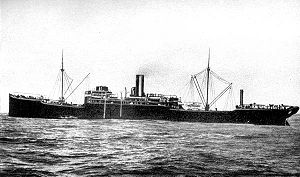SMS Wolf (auxiliary cruiser)
 Hilfskreuzer SMS Wolf | |
| Career (German Empire) | 44px |
|---|---|
| Name: | SMS Wolf |
| Ordered: | 1913 |
| Builder: | Flensburger Schiffbau Gesselschaft |
| Commissioned: | 16 May 1916 |
| Out of service: | 1918 |
| Fate: | Scrapped 1931 |
| General characteristics | |
| Displacement: | 11,200 tons (5809 tons gross register tonnage) |
| Length: | 135 m |
| Beam: | 17.1 m |
| Draught: | 7.9 m |
| Propulsion: | 1 shaft VTE steam engine, 3 boilers |
| Speed: | 11 knots |
| Complement: | 348 |
| Armament: |
7 - 150mm guns, 3 - 52mm guns, 4- 500 mm torpedo tubes, 465 mines |
| Aircraft carried: | 1 Friedrichshafen FF.33 seaplane |
SMS Wolf (formerly the Hansa freighter Wachtfels of 5809 GRT) was an armed merchant raider or auxiliary cruiser of the German Imperial Navy in World War I. She was the fourth ship of the Imperial Navy bearing this name (and is therefore often referred to in Germany as Wolf IV), following two gunboats and another auxiliary cruiser that was decommissioned before seeing action.
Description and history
As a commerce raider, the Wolf was equipped with six 15-cm guns, three 5.2-cm guns and several smaller caliber weapons as well as four torpedo tubes. She also carried over 450 mines to be dropped outside enemy ports; she laid one minefield off Australia's southern coast which claimed several ships. Her commander was Fregattenkapitän (Commander) Karl August Nerger who was in charge until her return to Kiel, Germany in February 1918.
The Wolf had not been designed for speed and her top speed was a mere 11 knots. Her advantages included deception (fake funnel and masts which could be erected or lowered to change her appearance), false sides which kept her weapons hidden until the last possible moment, and a range of over 32,000 miles thanks to a coal bunker capacity of 8,000 tons (assuming a cruise speed of 8 knots, burning 35 tons of coal daily).[1]
On 30 November 1916 the Wolf left her home port of Kiel with a crew of 348 men. Escorted by the submarine U-66 from Skagerrak to the North Atlantic, she passed north of Scotland and turned south going around the Cape of Good Hope, where she laid some of her mines, into the Indian Ocean. She dropped mines at the harbors of Colombo and Bombay, then entered the waters of South Asia, Australia and New Zealand.
With the help of the "Wölfchen" (Little Wolf), a Friedrichshafen FF.33 two-seater seaplane, she located and seized enemy vessels and cargo ships. After transferring their crews and any valuable supplies (notably coal, but also essential metals of which the German war effort had much need) to the Wolf, she then sank the vessels. The Wolf destroyed 35 trading vessels and 2 war ships, altogether approximately 110,000 tons.
After 451 days she returned to her home port of Kiel on 24 February 1918 with 467 prisoners of war aboard. In addition she carried substantial quantities of rubber, copper, zinc, brass, silk, copra, cocoa, and other essential materials taken from her prizes. The Wolf, without support of any kind, had made the longest voyage of a warship during World War I. Captain Nerger was awarded the highest German decoration, the Pour le Mérite.
For the remainder of the war, the Wolf was employed in the Baltic Sea. After the war she was ceded to France and sold to Cie. Messageries Maritimes of Paris, refitted and renamed Antinous. She was scrapped in 1931 in Italy.
A member of the crew was the young Theodor Plivier, who became later a revolutionary, communist and famous author. In his first novel Des Kaisers Kulis (The emperor's coolies) he assimilates his experience on board the Wolf. The book was transformed in a theatrical play, too, and forbidden after the National Socialist Machtergreifung.
Gallery
- Woelfchen 1.jpeg
Aircraft Wölfchen
- Karl-Aug2.jpeg
Commander Karl August Nerger
- Wolf voyage.jpg
Map of the Voyage of Wolf
Bibliography
- Richard Guilliatt & Peter Hohnen, The Wolf, William Heinemann Publ., Australia, 2009
- Edwin P. Hoyt, "Raider Wolf, The Voyage of Captain Nerger," 1916-1918, New York, 1974, ISBN 978-0-8397-7067-1
- Karl August Nerger, "S.M.S. Wolf", Scherl Verlag Berlin, 1918
- Fritz Witschetzky "Das schwarze Schiff", Union Deutsche Verlagsgesellschaft, Stuttgart/Berlin/Leipzig, 1920
- Roy Alexander, The Cruise of the Raider Wolf, Yale University Press, 1939.
- Schmalenbach, Paul German raiders: A history of auxiliary cruisers of the German Navy, 1895-1945 (Naval Institute Press 1979) ISBN 0870218247.
- Theodor Plivier: Des Kaiser Kulis. Roman der deutschen Kriegsflotte, Berlin 1930.
References
- ↑ [Guilliatt, Richard and Peter Hohnen, The Wolf that ravaged the Pacific, Book Excerpt, Wall Street Journal, Weekend Section, April 10–11, 2010, p.W3]
External links
| SMS Wolf (auxiliary cruiser)
]]
